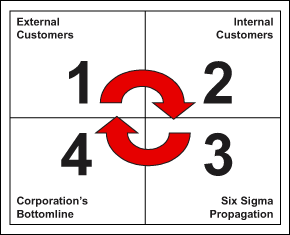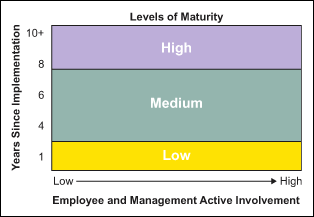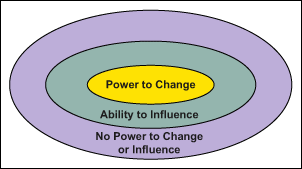
The question is simple: What type of projects should a Black Belt be conducting or considering? There are only so many hours in a day. And there is an abundance of demands, requirements and deadlines, coupled with ever-present and growing resource constraints.
Black Belts are expected to complete projects that save money, as well as projects that help the organization meet internal and external customer expectations. At the same time, they also must work on projects that prove the worth of Six Sigma to doubters and naysayers. To achieve all of these objectives, Black Belts should consider creating a balanced project portfolio.
Much like a financial advisor recommends an investment portfolio that is diversified (various assets) and balanced (varying levels of risk), a Black Belt portfolio should contain a mix of projects. This minimizes exposure to loss of support for the deployment on the part of customers and doubters, while ultimately improving the company’s bottom line through carefully selected initiatives.
Getting Started
When Black Belts are planning for projects to become part of a balanced portfolio, a number of questions may come to mind:
Question 1: Should I spend all my time working on projects that save money for my organization by reducing costs or expenses?
Answer: No. Your organization is only one of many customers you service as a Black Belt. Do not forget about external customers (those who supply you raw materials or those who buy your products and/or services).
Question 2: If I scope out projects that will save my organization money, will it help foster Six Sigma in my organization?
Answer: Not always. If you only look to save money, you might miss out on adding value to your organization. For example, it might be tempting to scope out a project that addresses employee attrition. It might take you three months to finish the project that reduces attrition by 25 percent. Attrition, however, might not be a big concern of the production supervisor, who is suffering a long-term problem of increasing amounts of scrap metal that is compounded by the increasing costs of metal.
Question 3: Do my external customers really care about Six Sigma?
Answer: They might not be familiar with Six Sigma, but they are concerned about product quality, costs and associated delivery of said product. They might not care if you use total quality management, Six Sigma, Lean Six Sigma or theory of constraints. They just want the best from your organization at a low price.
Using the Six Sigma Project Matrix
One tool to consider when selecting projects for a balanced portfolio is the Six Sigma project matrix (Figure 1).

The Matrix shows four distinct categories of projects based on the recipient of the efforts and deliverables of a project:
- External customers: An organization, entity, company, or group that either supplies the organization with raw materials or provides services, or that is a recipient of the organization’s output (i.e., services or goods).
- Internal customers: Departments, divisions, teams or individuals that are internal to the organization. These are the employees and mid- and upper-level managers that work for the organization.
- Six Sigma propagation: Calculated efforts by the organization and/or the Black Belt to increase awareness, acceptance and use of Six Sigma at all levels of the organization. This particular type of propagation is solely for the building and maintenance of Six Sigma “critical mass” – the smallest amount of support needed for a continued, sustained process-improvement environment at the organization.
- Corporation’s bottom line: Specific and directed efforts to reduce costs. Notice this does not include improved efficiency or increased production, though these two may result. The corporation’s bottom line is a concerted effort to reduce cost wherever possible.
The numbering scheme displayed in Figure 1 corresponds with the priority of each section of the matrix. The top area to be operating in is external customers. This is the bread and butter of an organization. If the external customers are not taken care of, your business will decline. Projects that are selected should provide positive, value-added improvements to customers or to the processes that affect them.
Surprising to most, corporation’s bottom line is listed as a No. 4. Although bottom line is important, if a Black Belt or team focuses exclusively on saving money for the corporation through reduction of expenses with little attention to anything else, a lot of other worthy projects will be missed.
Given this ranking scheme, should a Black Belt create projects that only affect the external customers? No. When creating, evaluating and monitoring their project portfolio, a Black Belt should have projects that fall into each of the four quadrants. The exact percentage of projects in each of the four quadrants will depend on the organization’s Six Sigma maturity level.
Determining Maturity
Figure 2 shows the varying levels of Six Sigma maturity based on years since implementation of the Six Sigma program and the level of involvement by both management and employees. Implementation is the date when Six Sigma was officially kicked off at the corporation. Level of involvement by management and employees is a subjective estimate that is based on management’s public and private support of Six Sigma, along with management and employees’ involvement in the execution and integration of Six Sigma into daily operations.

Finding the Right Balance
For corporations with a low level of Six Sigma maturity due, more quadrant 3 (Six Sigma propagation) projects should be expected. The quick completion of these projects can create forward momentum that encourages active involvement by all levels of management and employees.
Corporations with a high level of Six Sigma maturity (based on eight or more years since implementation and highly involved employees and management) should have more projects in quadrant one (external customers). The critical mass developed over time in these corporations should zero in their efforts to maximize the impact of Six Sigma by focusing on the external customers. This long-range outlook will benefit both the corporation and its external customers.
Additional Considerations
Besides selecting projects based on the Six Sigma project matrix and the organization’s Six Sigma maturity level, the Black Belt must be able to determine the likelihood of impact and sustainability of the solutions or recommendations from a potential project. Not every project should be started, even potential quadrant one projects, because they contain some variables that are out of a Black Belt’s reach. Figure 3 shows three areas that potential projects could fall into based on the probable impact or lack thereof.

The ideal project location is in the power to change area. In this area a Black Belt can make a difference by creating solutions and interventions that make processes more productive and lean. An example would be a manufacturing process that gets leaned by eliminating non-value-added steps.
The ability to influence area designates those projects that give Black Belts only the ability to influence, with the ultimate goal of promoting positive change. An example would be a project that focuses on reducing attrition of entry-level employees. A Black Belt can change the incentives or pay structure and even the working environment, but these changes do not necessarily translate to increased retention. All the changes mentioned exert positive influence with a stated goal of reducing attrition.
The third area, one in which any Black Belt would want to avoid, is where there is no power to change or influence the process under review. A lot of resources and patience could be expended working a project that does not create any solution or recommendation of substance because the Black Belt or management has no power to change or influence. For instance, consider a potential project where the goal is to increase sales of a particular item. If the current economic climate is creating negative pressure on the typical consumer, thereby reducing demand of the product, the typical Black Belt has no power to change or influence that external customer. There is nothing they can do to improve the economic climate to promote sales of the item in question.
Proper scoping is the key to getting in the power to change area. The Define phase of DMAIC must be carefully adhered to in order to promote projects with possible solutions that can change outcomes to meet or exceed the goal of the project. A project in quadrant 1 of the matrix, and in area where the Black Belt has the power to change is the ideal location to strive for.
Selecting Projects That Answer Common Questions
The Six Sigma project matrix helps create a project portfolio that has both substance and merit. By partitioning projects into the four quadrants of the matrix, Black Belts ensure answers are provided to typical questions asked each day in the business world:
- How can we bring value to our customers?
- How can we get our employees to work smarter?
- How can we spread the Six Sigma methodology to all levels of the organization?
- How can we increase savings?